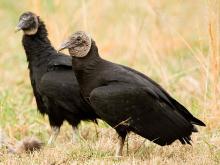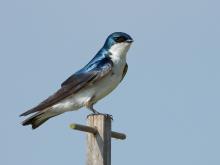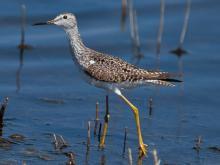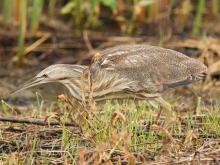Birds
Media

Species Types
Scientific Name
Sayornis phoebe
Description
Eastern phoebes often build their mud-and-plant nests on the side of a house, just under a roof or other overhang. These small flycatchers repeatedly cry out their own name: “FEE-bee! FEE-bee!”
Media

Species Types
Scientific Name
Coragyps atratus
Description
Although turkey vultures are much more common in Missouri, black vultures are expanding their range northward, and sightings of them are increasing. Note their black head, shorter tail, and (seen from below) a white patch near the ends of the wings.
Media

Species Types
Scientific Name
Tachycineta bicolor
Description
Tree swallows are sleek, agile fliers with white underparts and dark upperparts that look glossy blue or blue-green in good light. They are common migrants in Missouri. People most often see them chasing flying insects over wetlands and other aquatic habitats.
Media

Species Types
Scientific Name
Tringa flavipes
Description
The lesser yellowlegs migrates through Missouri in spring and fall, its numbers peaking in late April and late August. Identify this dainty, bright-yellow-legged shorebird by its color pattern and bill.
Media

Species Types
Scientific Name
Calidris melanotos
Description
The pectoral sandpiper migrates through Missouri in spring and fall. Its numbers peak in May and September. Identify this medium-sized, chunky shorebird by the sharp boundary between its dark-streaked breast and clear white belly.
Media

Species Types
Scientific Name
Himantopus mexicanus
Description
The black-necked stilt migrates through Missouri in spring and fall. In summer, it breeds locally in the Bootheel. It’s easy to identify, with its black back, white belly, long pink legs, and long, thin, straight bill.
Media

Species Types
Scientific Name
Riparia riparia
Description
Bank swallows are brown above and white below, with a dark brown band across the breast. In Missouri, they are a locally common summer resident, nesting in holes they excavate in steep mud embankments.
Media

Species Types
Scientific Name
Stelgidopteryx serripennis
Description
Northern rough-winged swallows are sleek, agile fliers with brown upperparts, brownish-white throat, and whitish underparts. They are common summer residents in Missouri. People most often see them chasing flying insects over land or water.
Media

Species Types
Scientific Name
Gavia immer
Description
The common loon, the iconic yodeling bird of northern lakes, may be seen in Missouri during migration and winter. It's less likely we'll see their black-and-white breeding plumage here, but their large size, distinctive shape, and diving behavior helps ID them.
Media

Species Types
Scientific Name
Botaurus lentiginosus
Description
The American bittern is a well-camouflaged, stealthy heron that lives in wetlands, lakes, and ponds. In Missouri, we usually see it in spring and fall. Listen in spring, at predawn or dusk, for its distinctive gulping calls.
See Also







Media

Species Types
Scientific Name
Hemaris diffinis
Description
The snowberry clearwing is a moth that confuses people because it looks like a bumblebee and flies like a hummingbird!
Media

Species Types
Scientific Name
Hyles lineata
Description
The white-lined sphinx moth sometimes confuses people because it flies, hovers, and eats from flowers like a hummingbird. The adults often fly during daylight hours as well as in the night and are often found at lights.
Media

Species Types
Scientific Name
Darapsa myron
Description
The Virginia creeper sphinx moth is common in woods and brushy areas and comes to lights at night. The larvae eat Virginia creeper and grape leaves.
Media

Species Types
Scientific Name
Perimyotis subflavus (formerly Pipistrellus subflavus)
Description
Tri-colored bats, formerly called eastern pipistrelles, are relatively small and look pale yellowish or pale reddish brown. The main hairs are dark gray at the base, broadly banded with yellowish brown, and tipped with dark brown.
Media

Species Types
Scientific Name
Myotis grisescens
Description
Gray myotises are difficult to distinguish from other mouse-eared bats. A key identifying feature of the gray myotis is that its wing is attached to the ankle and not at the base of the toes. It’s an endangered species.
Media

Species Types
Scientific Name
Myotis lucifugus
Description
The little brown myotis (little brown bat) is one of our most common bats, but populations are declining. White-nose syndrome has taken a heavy toll in northeastern states. This species is now listed as vulnerable across its range.
Media

Species Types
Scientific Name
Myotis sodalis
Description
The Indiana myotis, or Indiana bat, summers along streams and rivers in north Missouri, raising its young under the bark of certain trees. It is an endangered species.
About Birds in Missouri
About 350 species of birds are likely to be seen in Missouri, though nearly 400 have been recorded within our borders. Most people know a bird when they see one — it has feathers, wings, and a bill. Birds are warm-blooded, and most species can fly. Many migrate hundreds or thousands of miles. Birds lay hard-shelled eggs (often in a nest), and the parents care for the young. Many communicate with songs and calls.





















